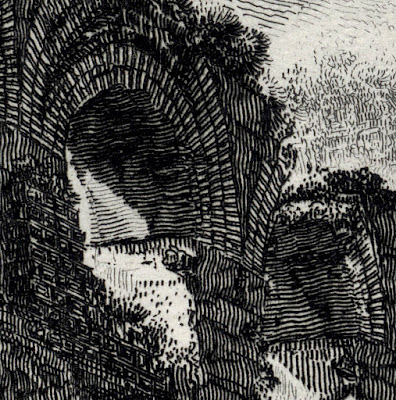Giovanni Battista Piranesi
(1720–78)
“Aqueduct of
the Acqua Claudia” or “Avanzi degli archi che […] conducevano l’Acqua Claudia
sul Palation” (View of the remains of the houses of the Caesars on the
Palatine), 1756, from the series, “Le Antichità Romane”, Plate XXXIIII, figure
II of the first volume, 1756
Etching on
heavy wove paper with the Papal Calcografia Nazionale dry stamp (19th century
edition) at lower-right corner.
Size: (sheet)
30.8 x 41.8 cm; (plate) 13.5 x 20.3 cm
Inscribed with
title, numbered and with a key for identification; signed at lower right
'Piranesi Arch. dis. inc.'
Taschen 201;
Focillon 210; Wilton-Ely 345
The British
Museum offers a description of this print: http://www.britishmuseum.org/research/collection_online/collection_object_details.aspx?objectId=3010647&partId=1&searchText=piranesi+Aqueduct&page=1
Condition:
Superb and strong nineteenth century Papal Calcografia dry stamped impression
in near pristine condition.
I am selling
this small—compared to many of Piranesi’s huge prints—but absolutely
magnificent etching by the great master, Piranesi, with all the hallmarks of his
technical skill and grand vision for a total cost of AU$246 (currently US$188.83/EUR170.67/GBP152.05
at the time of this listing) including postage and handling to anywhere in the
world.
If you are
interested in purchasing this posthumous but genuine Piranesi etching in
virtually flawless condition, please contact me
(oz_jim@printsandprinciples.com) and I will send you a PayPal invoice to make
the payment easy.
This print has been sold
Although most
folk are familiar with the etchings of Piranesi and his grand vision of ancient
Roman architecture—such as this superb example—what is seldom discussed are the
interesting ways that he moulds his images so that the portrayed architecture seems
more awe inspiring and visually intriguing than it probably is in reality.
For example,
note how Piranesi uses strong theatrical lighting to ensure that the fundamental
forms of the structures seem solid, simple and massive. Note also how Piranesi
will insert lace-like plant at very calculated spots within the eroding pieces
of architecture so that a viewer will be reminded of the ephemeral nature and
futility of man’s handiwork.
In fact, there are
so many interesting visual devices that Piranesi employs that I fully
understand the spell—the Piranesi effect—that this great master has cast on
today’s artists (see, for example, “The Piranesi Effect” [2015] edited by Kerrianne Stone & Gerard Vaughan
in which many Aussie artists, including my own work, is featured).







No comments:
Post a Comment
Please let me know your thoughts, advice about inaccuracies (including typos) and additional information that you would like to add to any post.